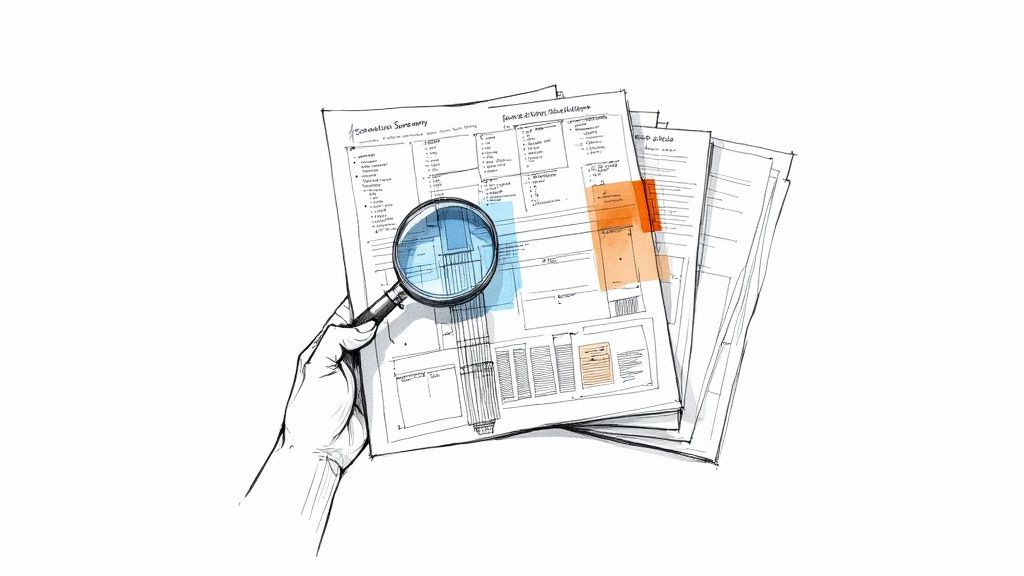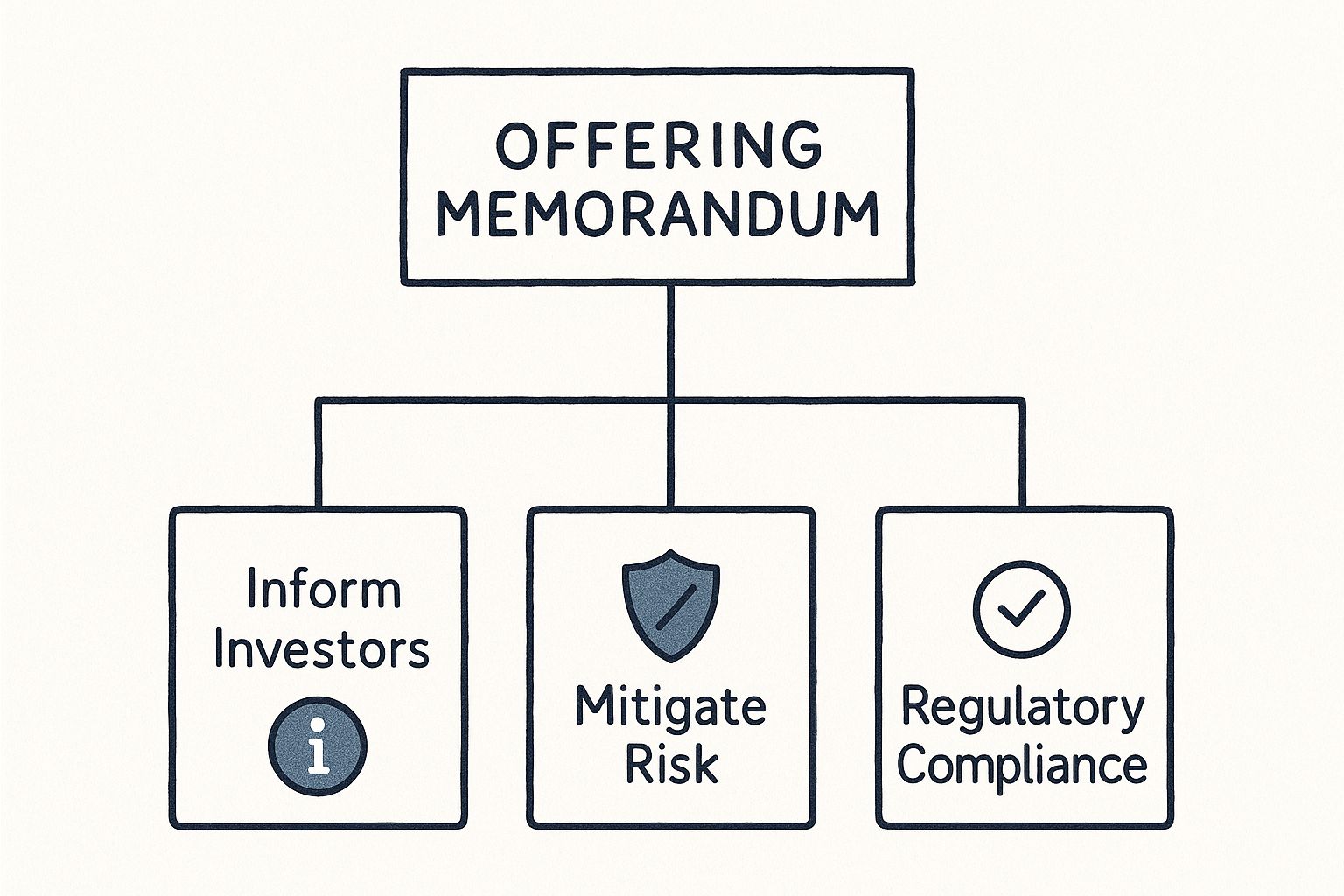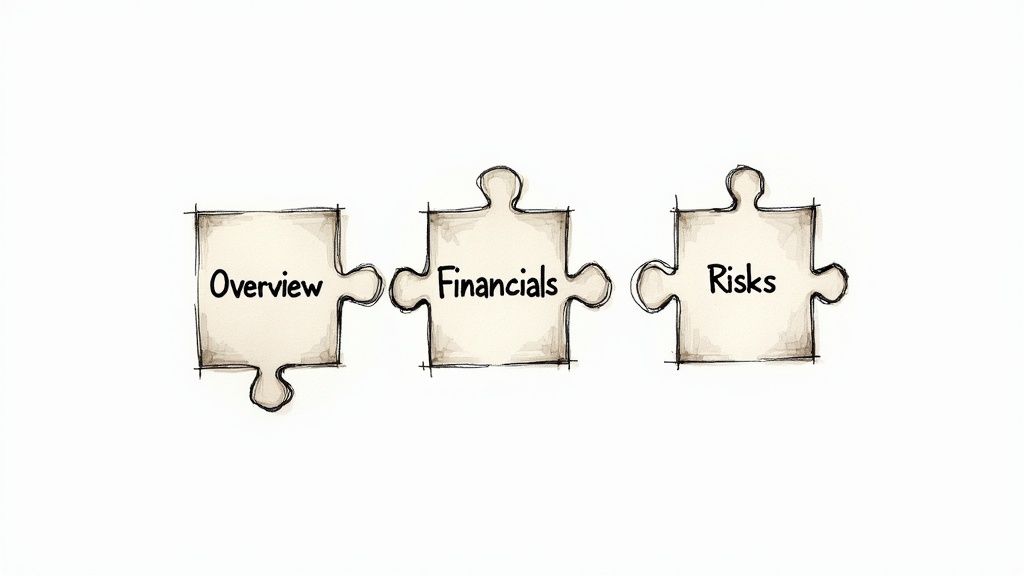What is an Offering Memorandum? Essential Guide for Investors

When you get a new multifamily deal across your desk, the first thing you'll look for is the offering memorandum, or OM. Think of it as the property's official story. It’s a detailed business plan laid out by the seller to give potential buyers like you a clear look under the hood.
This isn't just a marketing flyer. It's the full package of information you need to decide if an investment is even worth your time.
Your First Look at an Offering Memorandum

Imagine you're thinking about buying a used car. You wouldn't make a decision based on a couple of glossy photos, right? You'd want to see the service records, check the mileage, and understand its real performance history.
An OM serves the exact same purpose for a real estate investment. It’s the seller’s detailed presentation of the asset, and it goes far beyond a simple brochure. Its whole point is to give you a complete enough picture to start analyzing the deal seriously and make a smart decision.
The Foundation of Private Deals
The OM has been a key part of private capital markets for over a century, changing right alongside U.S. securities laws. It all started with the Securities Act of 1933, which drew a clear line between public offerings which need a formal prospectus and private placements aimed at specific, sophisticated investors. These private deals rely on an OM for disclosure.
Today, most of these private offerings fall under Regulation D, and it's estimated that over 90% of them use an OM. To really dig into the legal and structural side of things, check out this essential guide to a Private Placement Memorandum.
The numbers tell the story. By 2021, Regulation D filings soared past 38,000 annually, raising an estimated $1.5 trillion in capital each year. That's more than double what was raised in the U.S. public equity markets during the same period, showing just how important these documents are to modern investing.
Why the OM Matters to You
So, what does all this mean for your day to day investment process? Simple: the OM is your starting point. It's the foundation upon which your entire analysis, your underwriting, is built.
This is the first serious look you get into a property's actual operations and future potential. A well prepared OM hands you:
- A clear snapshot of the property’s current financial health.
- The seller's vision for where performance and growth can go.
- Key details about the local market and the competitive landscape.
To help you remember its role, here's a quick breakdown of what an OM provides.
Offering Memorandum at a Glance
| Key Function | What It Provides You |
|---|---|
| Initial Due Diligence | The foundational data to start your underwriting and verify the seller's claims. |
| Financial Storytelling | The narrative behind the numbers, historical performance and future projections. |
| Market Context | A detailed look at the submarket, competitors, and demographic trends. |
| Risk Disclosure | An outline of potential risks associated with the property and the investment. |
Ultimately, the OM sets the stage for every question you'll ask, every assumption you'll test, and every number you'll crunch as you decide whether to move forward. It’s step one.
Breaking Down the Anatomy of an OM
The first time you crack open an offering memorandum, it can feel like a firehose of information. These documents are dense, often running between 50 to 150 pages, and they’re packed with charts, legal jargon, and financial tables. But once you get the hang of it, you’ll see they all follow a predictable pattern.
Think of an OM as the owner’s manual for the property. Each section has a specific job, guiding you from the high level sales pitch down to the nitty gritty details. Knowing where to look for what is the first step toward getting through your deal flow efficiently.

This breakdown is a good reminder that an OM isn’t just marketing fluff. It’s a critical document for legal protection, financial transparency, and making an informed decision.
The Executive Summary: The Thirty-Thousand-Foot View
This is always your first stop. The executive summary is the highlight reel for the entire deal, designed to give you the most important information in just a few pages. It tells the story of the property and why it’s a compelling investment.
Here you’ll find the core stats: address, unit count, asking price, and key metrics like the cap rate and projected cash on cash return. It's meant to hook you and convince you to keep reading. While it’s definitely the broker’s sales pitch, it also serves as your roadmap for the rest of the document.
Property and Market Analysis: Where the Asset Lives
After the summary, the OM gets into the physical asset itself and the neighborhood it sits in. These sections paint a picture of what you’re actually buying and the market forces that will make or break its success.
You’ll almost always see these components:
- Property Description: This covers the hard facts. Year built, construction type, amenities, and recent capital improvements. It answers the basic question, "What shape is this building in?"
- Location Overview: Here, you get the story of the neighborhood. Think major employers, transportation links, and local attractions that keep the area desirable for tenants.
- Market Analysis: This section brings in the data on local economic trends, population growth, and rental market conditions. The goal is to build a case for future demand and rent growth.
- Competitive Set: The OM will list several nearby properties as rent comparables. Pay very close attention here. Brokers are notorious for cherry picking comps that make their property look like a bargain.
The Financial Section: The Heart of the Deal
Alright, this is where the real work begins. The financial section contains the property's historical performance data like the T12 and the seller's projections for the future, known as the pro forma. This is the raw material you'll use to build your own model.
The numbers in an OM tell a story, but it’s the seller’s version of the story. Your job is to verify every assumption and write your own version based on conservative, realistic data.
A good OM provides detailed financials, sometimes including years of audited statements, specific growth assumptions, and a full breakdown of the capital stack. Risk disclosures are a legal must have. One study found that 75% of OMs for private equity funds listed between 15 and 30 distinct risk factors.
This section is the foundation of your entire analysis, a topic we cover in our complete guide to multifamily real estate underwriting.
Reading Between the Lines of Financial Projections

After you've walked the property and sized up the neighborhood, you’ll hit the heart of the offering memorandum: the financials. This is where your real work as an investor kicks in. The numbers presented here are called the pro forma, which is the seller’s best case vision for the property's financial future.
It’s important to remember these are just projections, not guarantees. The pro forma is designed to show the property in its most flattering light, often painting a picture of flawless operations and optimistic growth. Your job is to separate this financial storytelling from reality.
This means you need to challenge every single assumption, from rent growth projections to expense estimates. By stress testing these numbers, you can build your own financial model based on what’s probable, not just what’s possible on a perfect day.
Spotting Overly Optimistic Assumptions
Sellers and their brokers are selling a story, and the numbers are there to back it up. It’s common to see a pro forma that assumes aggressive rent increases or suspiciously low operating expenses. For example, a projection might show a 10% jump in rental income in the first year alone.
Is that really achievable? Maybe, if there's a clear plan to renovate every single unit. But if the local market is only seeing 3% average rent growth, you need to question that assumption hard. A property almost never outperforms its submarket that dramatically without an ironclad reason.
Apply that same skepticism to the expense side. Be wary of projections that show maintenance costs or property taxes staying flat for the next five years. That’s just not how the real world works. For instance, property taxes are often reassessed right after a sale, which can lead to a significant and painful spike in your operating costs.
Seller's Pro Forma vs. Your Underwriting
Let's walk through a quick example. Imagine you're looking at a 100 unit apartment building. The seller's pro forma might present a picture perfect scenario, but your own conservative underwriting will likely tell a different story. Building a solid financial model is a core part of the multifamily real estate underwriting process that turns raw data into smart decisions.
Here’s a look at how those two perspectives can clash.
Seller's Pro Forma vs. Your Underwriting
| Financial Metric | Seller's Pro Forma Example | Conservative Underwriting Example | Key Question to Ask |
|---|---|---|---|
| Year 1 Rent Growth | 8% (Based on planned cosmetic upgrades) | 4% (Aligned with market average plus a small premium) | Is an 8% bump realistic for this submarket and asset class? |
| Vacancy Rate | 3% (Best case scenario) | 5% (Historical average for the area) | What has the property's actual vacancy been for the last 3 years? |
| Property Taxes | $50,000 (Based on current assessment) | $60,000 (Adjusted for post sale reassessment) | What will the new assessed value be after the sale? |
| Repairs & Maintenance | $350/unit (Assumes no major issues) | $500/unit (Includes a buffer for unexpected repairs) | Does this budget account for the age of the roof, HVACs, and pipes? |
This comparison shows why you can't just take the seller's numbers at face value.
An offering memorandum provides the seller's financial argument. Your underwriting is your rebuttal, grounded in market data, historical performance, and a healthy dose of professional skepticism.
By asking tough questions and building your own model, you move from simply accepting the seller’s story to creating your own. This disciplined approach is what protects your capital and uncovers the true potential or hidden risks of any investment opportunity.
Finding the Hidden Stories in the Rent Roll
If the financial proforma in an offering memorandum is the seller's highlight reel, the rent roll is the raw, unedited footage. This document is so much more than a list of tenants and their monthly payments. It’s a live snapshot of the property's day to day health and, frankly, the most critical piece of data in the entire OM.
By treating the rent roll like a detective story, you can uncover key insights that the glossy executive summary will never mention. You learn to see the property not just as a pile of bricks and units, but as a living community of individual leases, each with its own story. This is where the real operational picture comes into focus.
Uncovering Tenant Stability and Risk
The first thing I look at is the lease structure. Are most tenants on standard 12 month leases, or is there a concerning number of month to month agreements? A building full of month to month tenants can be a huge red flag for instability, hinting at a transient resident base and a higher risk of sudden vacancy.
Next, I scan for patterns in lease expiration dates. A big cluster of leases all ending in the same two month period could spell trouble. That’s a potential income gap waiting to happen if a few of those tenants decide not to renew at the same time.
The rent roll doesn’t just show you who is paying rent; it shows you how secure that income stream really is. Every lease expiration is a risk, and every month-to-month tenant is a potential vacancy notice.
This document is your best tool for spotting these hidden risks before they become your headache after closing.
Spotting Opportunities and Red Flags
Beyond just spotting risk, the rent roll is where you find the upside. See a dozen leases set to expire in the next 90 days with rents that are 15% below the current market rate? You’ve just found a clear value add opportunity. That’s your chance to bring those units up to market and immediately boost the property’s income.
On the flip side, you have to watch for outliers that make the property look better than it is. Are one or two tenants paying unusually high rent, skewing the building's average? These "loss to lease" situations might look great on paper, but they can hide weakness in the property's true market position. You also need to check for delinquencies. A long list of residents who are consistently late with payments signals collection issues ahead.
For investors who need to process this data quickly, using tools for automated rent roll data extraction can turn this complex analysis into a much faster process.
Ultimately, the rent roll is where you confirm or challenge the story told in the rest of the offering memorandum. It’s not just a spreadsheet; it’s the most honest account of the property's performance you'll get.
How to Analyze the Local Market and Competition

A great property in a bad market is just a bad investment waiting to happen. The offering memorandum will always paint the sunniest possible picture of the local area, but you absolutely cannot take the market overview at face value.
Think of this section as the seller’s closing argument for why the city and neighborhood are poised for growth. Your job is to become a hardened skeptic and poke holes in that story. You have to do your own independent research. Treat the OM’s market section as a starting point. It’s a list of claims to be verified, not a conclusion to be accepted.
Verifying the Market Story
The OM will shout about all the positive trends, but what’s it whispering? Or worse, what is it leaving out completely? Real diligence means digging into the fundamental economic drivers that actually support a rental market.
Don’t just read their summary. Hunt down the original sources and look for the hard data on what makes an area tick:
- Job Growth: Are good paying jobs actually coming to town? Look for announcements from the local chamber of commerce or business journals about corporate relocations or major expansions. A new Amazon warehouse is a great sign; a call center closing is not.
- Population Trends: Is the city growing, shrinking, or just treading water? The U.S. Census Bureau and city planning departments provide the unbiased numbers you need to see the real direction of the population.
- New Development: What else is being built nearby? A new hospital or university campus is a massive plus. But that new 500 unit apartment complex going up next door could flood the market, stalling your projected rent growth before you even close.
This is the only way to know if the demand the OM describes is real or just a fantasy cooked up for the sale.
Analyzing the Competitive Landscape
Every OM has a "rent comparables" section showing how the property's rents stack up against the competition. Be extremely careful here. Brokers are masters at cherry picking comps that make their deal look like an absolute bargain.
The most important comps aren't the ones in the OM; they're the ones the broker conveniently left out.
Your mission is to build your own, more realistic competitive set. Get in your car and drive the neighborhood. Use Google Maps to spot every single apartment building within a one mile radius that’s fighting for the same tenants you are.
Once you have your own list, it's time for some quick and dirty analysis. Compare the essentials:
- Rental Rates: Call the properties or check their websites. What are they actually asking for rent right now on similar floor plans?
- Amenities: Does the comp have a renovated pool, a nicer gym, or in unit laundry? These are the features that let them command higher rents.
- Occupancy: When you call, just ask the leasing agent how things are going. High occupancy across the board is a fantastic sign of strong demand.
This simple process gives you a true sense of where the property really fits in its market and tells you if the seller's rent projections are achievable or just a pipe dream.
Your Next Steps After Reviewing the OM
Once you've torn apart the offering memorandum, the real work begins. The OM is your map, but now it's time to actually explore the territory. This is the moment your analysis turns into action, bridging the gap between what you’ve read on paper and what exists in the real world. You’re moving from theory to practical due diligence.
The first logical step? Turn all your questions and concerns into a structured list for the broker. Did you spot a discrepancy between the rent roll and the T12? Ask about it. Were the assumptions in the pro forma a little too optimistic? Challenge them directly. A clear, concise list of questions shows the broker you're a serious buyer who has actually done their homework.
From Document to Property Tour
With your initial questions answered, it's time to see the asset with your own eyes. A property tour isn't just a casual walk through. It's a mission to verify the story the OM told you. Bring a checklist based on your review, paying close attention to the property's physical condition, the quality of the tenants you see, and the overall feel of the neighborhood.
You can only learn so much from a document. This is your chance to connect the numbers to reality.
The offering memorandum gives you the property’s history and the seller’s projections. The property tour tells you its present reality and helps you form your own, more accurate vision for its future.
After your initial review and tour, you'll need access to all the supporting documentation. This is where you’ll find the raw files behind the OM’s polished summaries. Access to a secure data room is crucial here, and you can learn more from this essential guide to data rooms for due diligence.
Making an Informed Decision
Finally, it's time to pull everything together. Update your underwriting model with the real world information you gathered from your questions and the property tour. Compare your new, more realistic projections against the seller’s original numbers.
This refined analysis will form the foundation of your investment decision and, if you move forward, your offer. By following these steps, you can avoid some common pitfalls in multifamily property investment analysis and proceed with the confidence that comes from a thorough, hands on review.
Common Questions About the Offering Memorandum
Even after you've been through a few deals, the offering memorandum can still raise some questions. It sits in a weird space between a marketing brochure and a legal document. Let's clear up a few of the most common points of confusion.
Is an Offering Memorandum a Legally Binding Contract?
In a word, no. The OM itself isn’t the contract that seals the deal. Think of it more as a formal, detailed sales pitch. You aren't legally on the hook for anything until you and the seller both sign a purchase and sale agreement (PSA).
However, and this is a big however, the OM carries serious legal weight. It's a formal disclosure document. If the seller or their broker includes information that is materially false or misleading, they can be held liable. So while it's not the final contract, it’s a document that everyone involved takes very seriously.
Who Actually Puts the OM Together?
Typically, the seller’s commercial real estate broker or their investment sales team is responsible for creating the offering memorandum. They work hand in hand with the property owner to gather all the financials, operational details, and market research needed.
Their job is to walk a fine line. They present the property in its best possible light to attract serious buyers, while also providing enough factual data for you to start your underwriting and due diligence. The final product is a carefully crafted blend of salesmanship, financial reporting, and disclosure.
An offering memorandum is the bridge between a seller's desire to market a property and a buyer's need for detailed, factual information to make an investment decision.
How Is an OM Different From a Property Brochure?
This is a great question because they can sometimes look similar at first glance. A property brochure is pure marketing. It's the glossy, two page flyer designed to grab your attention with beautiful photos and high level selling points. It's all about creating initial interest.
An offering memorandum is where the real work begins. While it definitely has marketing elements, its main purpose is to deliver substantive data for your analysis. You’ll find things in an OM that would never be in a simple brochure, including:
- The complete T12 (trailing 12 month) operating statement and the current rent roll.
- Deep analysis of the local submarket, rent comparables, and sales comparables.
- A full breakdown of the property's physical specs, from the roof's age to the HVAC system.
- Disclosures about known issues, potential risks, or other legal considerations.
To put it simply: a brochure makes you pick up the phone. An OM gives you the data you need to decide if you want to make an offer.
Ready to stop wasting hours manually copying data from OMs into your spreadsheets? QuickData.ai uses AI to instantly extract and structure data from any offering memorandum, rent roll, or T12 directly into your Excel model. Try it free for 14 days and underwrite deals faster.
Article created using Outrank
